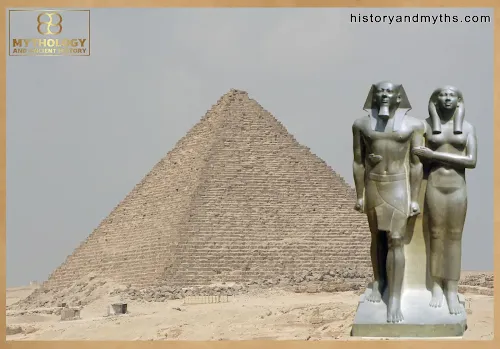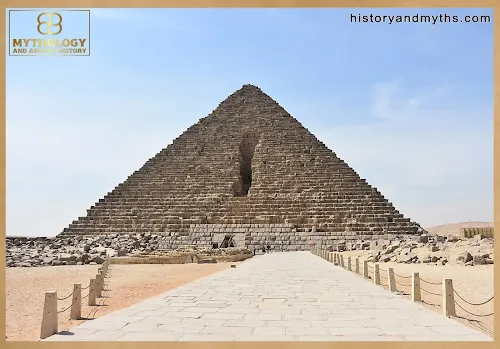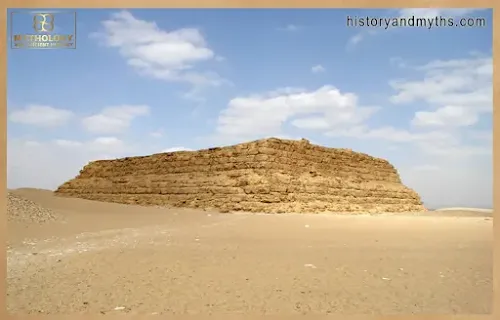The Political Turmoil After Khafre's Death
The opposition party in the royal family was able to seize power after Khafre's death.
Our little information does not allow us to delve into this topic, or to know how long the period of instability lasted, or to say with certainty whether Khafre and Menkaure were ruled by one of Khafre's brothers or by two kings.
Why did Menkaure build a smaller pyramid and how did people perceive him?
The country returned to normal and King Menkaure began to build his pyramid close to the pyramids of his father and grandfather. The engineers designed it to be much smaller in size (66.5 meters high and 108.5 meters long) and they intended to cover it with granite instead of white limestone, but they only completed half of it.
 |
| Pyramid of Menkaure and statue of Menkaure and Queen Khamerernebty II |
The People’s Perception of Menkaure Compared to Khufu and Khafre
The priests told Herodotus a lot about how Khufu and Khafre oppressed the people and how the people hated them, and he also mentions how Menkaure went against the ways of his predecessors and ended the oppression and opened the temples, so the people loved him.
This story may have some truth to it. There is no doubt that the construction of Khufu and Khafre's pyramidal complexes and the tombs of their officials was a great burden on the country and the treasury, compounded by the rivalry between the two branches of the royal house, which the days could not alleviate.
The Incomplete Pyramid and Funerary Complex of Menkaure
Although Menkaure ruled for more than twenty-one years (and his reign may have extended to twenty-eight years), he was unable to complete the construction of his small pyramid, funerary temple or valley temple for this pyramid is built of adobe bricks and has nothing built with stone except for some floors, columns and lintels of chambers, and George Andrew Reisner found in this temple when he excavated it a number of sets of statues made of Schist stone, each of which represents King Menkaure with a symbol of a region and an important idol.
 |
| Granite casing blocks of Menkaure's Pyramid next to the entrance. Many are visibly unfinished, probably halted in mid-work due to the death of the pharaoh |
What happened to Menkaure’s pyramid and what did archaeologists find?
This pyramid was looted as others were looted in the era of the first period, but the thieves left a lot of what they did not need, and when Perring opened this pyramid in 1839, he found some parts of a mummy of a man and a broken wooden coffin that may have remained from the funerary furniture of the pyramid.
He also found a sarcophagus of Basalt stone whose inner and outer sides were decorated with the facade of the palace, but this sarcophagus sank with the ship that was carrying it to England when a severe storm hit it off the shores of Spain.
 |
| menkaure_burial_chamber |
How did political instability mark the final years of the Fourth Dynasty?
Shepseskaf ruled after his father, but he did not last more than four years, and this short period was characterized by an important incident that was a prelude to other incidents of great impact.
How did the rise of Ra priests impact the end of the Fourth Dynasty?
The influence of the sun priests began to increase since the Fourth Dynasty, but this influence was not dangerous in the days of Sneferu or Khufu, but it became strong since the reign of Khafre, and the name of the god Ra not only became part of the names of some kings and princes of the royal house for blessing, but the fifth name of the kings, the name of the son of Ra, also began to appear starting from the reign of King Khafre.
Why did Shepseskaf abandon pyramid building?
Shepseskaf wanted to put an end to this influence and power of the priests, so he abandoned the construction of his tomb in the form of a pyramid because of its connection to the worship of the sun, and wanted to neglect it, so he built his tomb in the form of a large sarcophagus (100 meters x 72 meters and 18 meters high), which is known as Pharaoh's Mastaba. In Saqqara, he built his funerary temple on its eastern side as usual and also erected the Wadi temple and the road connecting them, but the construction was not completed and Shepseskaf may not have been able to be buried in it.
 |
| Mastabat al-Fir’aun, Egypte, where king Shepseskaf was buried |
The Short Reign of Shepseskaf and Continued Instability
There was certainly a movement against the priests of Ra, but Shepseskaf did not live long enough to achieve what he aimed for, and soon the rivalry in the royal house resurfaced and one of them, perhaps Djedefptah, seized the throne and ruled for about two years. In these turbulent circumstances and the delicate period of the family's history, a lady from the royal family named Khentkaus I appears, forming the link between the fourth and fifth dynasties.
Who was Khentkaus I and what was her role between the Fourth and Fifth Dynasties?
In the winter of 1931-1932, Cairo University excavations in the Giza pyramids revealed the truth about the building that some thought was an unfinished pyramid, as it turned out that it was similar in design to the tomb of King Shepseskaf, in the form of a large sarcophagus built on a rock in the place, and that it was not a king, but a queen named Khentkaus.
Since this discovery, many archaeologists have tried to determine the position of this lady in the family. Opinions differed in some details, but it is now likely that she was a daughter of King Menkaure, although she did not mention this on her monuments, that she married Shepseskaf, although she also did not mention this, and that she lived during the two years ruled by Djedefptah, and it is believed that she married Userkaf, who founded the Fifth Dynasty and became the mother of his two sons who ruled after him one after the other, Sahure and Neferirkare, that is, she became the mother of the Fifth Dynasty.
All we can say is that Khentkaus I did not sit on the throne, that she was not buried in a pyramid but in a sarcophagus-shaped tomb, and that this tomb was different in design and grandeur from the tombs of other queens who lived in those days. Shepseskaf's revolt against the priests of Ra hastened the end of this dynasty, whose members had fought since Khufu's death.
The End of the Fourth Dynasty and the Dawn of the Fifth Dynasty
Finally, around 2560 BC. AD . The dynasty founded by Sneferu came to an end and was replaced by another dynasty of sun priests.
Sources
- Magli, Giulio. "The April 1, 2471 b.c. Eclipse and the End of the Fourth Egyptian Dynasty." arXiv, December 18, 2024.
- Sparavigna, Amelia Carolina. "Two Egyptian Kings, Shepseskaf and Userkaf, and a Solar Eclipse (2471 BC)." arXiv, December 29, 2024.
- "Solar Eclipse May Explain End of Egypt’s Fourth Dynasty." Jerusalem Post, April 2, 2025
- Bárta, Miroslav. “In the Reign of the Sun Kings.” Archaeology, Nov–Dec 2020
- Lehner, Mark. The Complete Pyramids: Solving the Ancient Mysteries. London: Thames & Hudson, 1997.
- Redford, Donald B., ed. The Oxford Encyclopedia of Ancient Egypt. 3 vols. Oxford: Oxford University Press, 2001.
- Ziegler, Charles. The Pharaohs of Ancient Egypt. New York: Macmillan, 1999.
- Harris, Michael, and David Macaulay. The Pyramids of Giza. Washington, D.C.: National Geographic Society, 2004.
- Wilkinson, Richard H. The Complete Temples of Ancient Egypt. London: Thames & Hudson, 2000.
